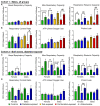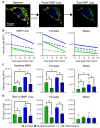Mitochondrial Transfer Improves Cardiomyocyte Bioenergetics and Viability in Male Rats Exposed to Pregestational Diabetes
- PMID: 33673574
- PMCID: PMC7956857
- DOI: 10.3390/ijms22052382
Mitochondrial Transfer Improves Cardiomyocyte Bioenergetics and Viability in Male Rats Exposed to Pregestational Diabetes
Abstract
Offspring born to diabetic or obese mothers have a higher lifetime risk of heart disease. Previously, we found that rat offspring exposed to late-gestational diabetes mellitus (LGDM) and maternal high-fat (HF) diet develop mitochondrial dysfunction, impaired cardiomyocyte bioenergetics, and cardiac dysfunction at birth and again during aging. Here, we compared echocardiography, cardiomyocyte bioenergetics, oxidative damage, and mitochondria-mediated cell death among control, pregestational diabetes mellitus (PGDM)-exposed, HF-diet-exposed, and combination-exposed newborn offspring. We hypothesized that PGDM exposure, similar to LGDM, causes mitochondrial dysfunction to play a central, pathogenic role in neonatal cardiomyopathy. We found that PGDM-exposed offspring, similar to LGDM-exposed offspring, have cardiac dysfunction at birth, but their isolated cardiomyocytes have seemingly less bioenergetics impairment. This finding was due to confounding by impaired viability related to poorer ATP generation, more lipid peroxidation, and faster apoptosis under metabolic stress. To mechanistically isolate and test the role of mitochondria, we transferred mitochondria from normal rat myocardium to control and exposed neonatal rat cardiomyocytes. As expected, transfer provides a respiratory boost to cardiomyocytes from all groups. They also reduce apoptosis in PGDM-exposed males, but not in females. Findings highlight sex-specific differences in mitochondria-mediated mechanisms of developmentally programmed heart disease and underscore potential caveats of therapeutic mitochondrial transfer.
Keywords: developmentally programmed heart disease; diabetic pregnancy; mitochondria; mitochondrial transfer.
Conflict of interest statement
The authors declare no competing interest.
Figures







Similar articles
-
Maternal high-fat diet impairs cardiac function in offspring of diabetic pregnancy through metabolic stress and mitochondrial dysfunction.Am J Physiol Heart Circ Physiol. 2016 Mar 15;310(6):H681-92. doi: 10.1152/ajpheart.00795.2015. Epub 2016 Jan 22. Am J Physiol Heart Circ Physiol. 2016. PMID: 26801311 Free PMC article.
-
Diabetic Pregnancy and Maternal High-Fat Diet Impair Mitochondrial Dynamism in the Developing Fetal Rat Heart by Sex-Specific Mechanisms.Int J Mol Sci. 2019 Jun 25;20(12):3090. doi: 10.3390/ijms20123090. Int J Mol Sci. 2019. PMID: 31242551 Free PMC article.
-
Consequences of a Maternal High-Fat Diet and Late Gestation Diabetes on the Developing Rat Lung.PLoS One. 2016 Aug 12;11(8):e0160818. doi: 10.1371/journal.pone.0160818. eCollection 2016. PLoS One. 2016. PMID: 27518105 Free PMC article.
-
Cardiomyocyte mitochondrial dysfunction in diabetes and its contribution in cardiac arrhythmogenesis.Mitochondrion. 2019 May;46:6-14. doi: 10.1016/j.mito.2019.03.005. Epub 2019 Mar 21. Mitochondrion. 2019. PMID: 30905865 Review.
-
Mitochondrial transfer in the progression and treatment of cardiac disease.Life Sci. 2024 Dec 1;358:123119. doi: 10.1016/j.lfs.2024.123119. Epub 2024 Oct 10. Life Sci. 2024. PMID: 39395616 Review.
Cited by
-
Mitochondrial Transportation, Transplantation, and Subsequent Immune Response in Alzheimer's Disease: An Update.Mol Neurobiol. 2024 Sep;61(9):7151-7167. doi: 10.1007/s12035-024-04009-7. Epub 2024 Feb 17. Mol Neurobiol. 2024. PMID: 38368286 Review.
-
The Mighty NUMT: Mitochondrial DNA Flexing Its Code in the Nuclear Genome.Biomolecules. 2023 Apr 27;13(5):753. doi: 10.3390/biom13050753. Biomolecules. 2023. PMID: 37238623 Free PMC article. Review.
-
Targeting mitochondrial transfer: a new horizon in cardiovascular disease treatment.J Transl Med. 2024 Dec 31;22(1):1160. doi: 10.1186/s12967-024-05979-x. J Transl Med. 2024. PMID: 39741312 Free PMC article. Review.
-
Mitochondrial transfer - a novel promising approach for the treatment of metabolic diseases.Front Endocrinol (Lausanne). 2024 Jan 19;14:1346441. doi: 10.3389/fendo.2023.1346441. eCollection 2023. Front Endocrinol (Lausanne). 2024. PMID: 38313834 Free PMC article. Review.
-
Transcriptomic and proteomic pathways of diabetic and non-diabetic mitochondrial transplantation.Sci Rep. 2022 Dec 21;12(1):22101. doi: 10.1038/s41598-022-25858-z. Sci Rep. 2022. PMID: 36543810 Free PMC article.
References
-
- Riskin A., Garcia-Prats J.A. Infants of women with diabetes. In: Weisman L.E., Wolfsdorf J.I., Kim M.S., editors. UpToDate. Wolters Kluwer; Online: 2020.
-
- Depla A.L., de Wit L., Steenhuis T.J., Slieker M.G., Voormolen D.N., Scheffer P.G., de Heus R., van Rijn B.B., Bekker M.N. Effects of maternal diabetes on fetal heart function at echocardiography: Systematic review and meta-analysis. Ultrasound Obstet. Gynecol. 2020 doi: 10.1002/uog.22163. - DOI - PMC - PubMed
MeSH terms
Grants and funding
LinkOut - more resources
Full Text Sources
Other Literature Sources
Medical
Research Materials
Miscellaneous

